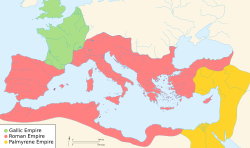Claudius Gothicus
- REDIRECT Template:Infobox royaltyClaudius (10 May 214–September 270 AD) was Roman emperor from 268 to 270. After 269, he was called "Gothicus" because of his military victories against the Goths.
Early life
Claudius (Latin: [Marcus Aurelius Claudius] Error: {{Lang}}: text has italic markup (help)) may have come from Illyricum in the Balkans, part of the Roman Empire. Latin historians (the authors of the Epitome de Caesaribus and the Historia Augusta) wrote that Claudius was the son of the emperor Gordian III, or was related to the emperor Probus. These claims are not true.[1]
The Historia Augusta says that Claudius was a military tribune (Latin: [tribunus militum] Error: {{Lang}}: text has italic markup (help)) in the army of the emperor Decius. After that, the Historia Augusta says that Claudius was leader of a Roman legion (Latin: [tribunus legionis] Error: {{Lang}}: text has italic markup (help)) in the time of the emperor Valerian. Next, the Historia Augusta says that Claudius was governor of all Illyricum (Latin: [dux totius Illyrici] Error: {{Lang}}: text has italic markup (help)) when Gallienus was emperor. The Latin historian Aurelius Victor and the Greek historian Zonaras wrote that Claudius was a tribune (Latin: [tribunus] Error: {{Lang}}: text has italic markup (help)) at Ticinum (Pavia, Italy) in 268.[1]
Emperor
Claudius became emperor in September or October 268. Soon afterwards his armies overcame the Alemanni in a battle at Lake Garda on the Italian Peninsula. Claudius got the title Latin: [Germanicus maximus] Error: {{Lang}}: text has italic markup (help) because of this success over the Germanic peoples. For the first winter of his reign (268–269) he may have been in Rome. In 269, Claudius was Roman consul. He and his armies overcame the Goths in a battle at Naissus (Niš, Serbia). After this, Claudius got the name Latin: [Gothicus maximus] Error: {{Lang}}: text has italic markup (help), because of his victory over the Goths.[1]
Death
In September 270, Claudius Gothicus died of plague in Sirmium (Sremska Mitrovica, Serbia). He was deified (made into a god), with the name in Latin: [Divus Claudius] Error: {{Lang}}: text has italic markup (help).[1]
Family
Claudius Gothicus had a brother, Quintillus.[2]
In the time of the later emperor Constantine the Great, the Historia Augusta says that Claudius Gothicus had another brother with the name Crispus and a sister with the name Constantina. The Historia Augusta also says that Claudius had a daughter with the name Claudia. This is not true.[1]
Claudius Gothicus Media
Antoninianus of Claudius II. Legend: IMPerator Caesar CLAVDIVS AVGustus
Roman emperor Gallienus, (r. 253–268)
Possible bust of Claudius, Santa Giulia Museum, Brescia (Italy).
Medallion of Claudius. An attempt of his to reform Roman currency is commemorated on the reverse with three Monetae, personifications of gold, silver, and bronze
Ruins of Imperial Palace at Sirmium, today in Sremska Mitrovica
Portrait head of a 3rd-century soldier-emperor, perhaps Claudius Gothicus (Worcester Art Museum).
References
- ↑ 1.0 1.1 1.2 1.3 1.4 Kienast, Dietmar; Eck, Werner; Heil, Matthäus (2017) [1990]. "Claudius II. Gothicus (Sept./Okt. 268–Sept. 270)". Römische Kaisertabelle: Grundzüge einer römischen Kaiserchronologie (in Deutsch) (6th ed.). Darmstadt: Wissenschaftliche Buchgesellschaft (WBG). pp. 222–223. ISBN 978-3-534-26724-8.
- ↑ Kienast, Dietmar; Eck, Werner; Heil, Matthäus (2017) [1990]. "Quintillus (September 270)". Römische Kaisertabelle: Grundzüge einer römischen Kaiserchronologie (in Deutsch) (6th ed.). Darmstadt: Wissenschaftliche Buchgesellschaft (WBG). p. 224. ISBN 978-3-534-26724-8.






